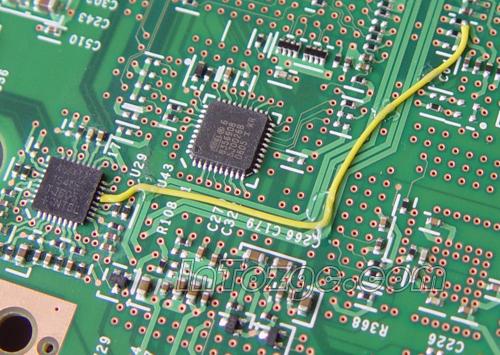
相关报道:
ThinkPad T60现重大缺陷!主板居然飞线 (替代链接)
联想承认ThinkPad飞线 否认质量问题 (替代链接)
这个是联想ThinkPad T60(P)主板背面的飞线,X60上也有类似的飞线。ThinkPad竟然也有飞线,粗看着实吓了一跳。不过仔细分析的话,其实也不是什么大问题,对本本质量没有影响。
首先,这条线还是焊得比较精细的,而且用蜡封固定,走线方向也没有大问题,所以这条线本身不会出什么大问题。
其次更为重要的是,这条线到底是干什么的。
先看看这块芯片,Maxim 1540E,根据1540A/1541的Datasheet,此芯片是专用于笔记本电脑,提供0.7~5.5V电源电压,双PWM控制器。可输出两个电压,可用于DDR或其他低电压IC的供电。相当重要的哦。
根据Datasheet,这条飞线是第13个引脚,也就是PGOOD2,Open-Drain Power-Good Output。Function: PGOOD2 is low when the output voltage is more than 10% (typ) above or below the normal regulation point, during soft-start, and in shutdown. After the soft-start circuit has terminated, PGOOD2 becomes high impedance if the output is in regulation. 就是说当输出电压异常的时候这个引脚会变成低电平。否则是高阻态。有可能原先是悬空的,估计这条飞线让他接上一个上拉电阻,既没有大电流,也不是高频率,正常的时候变成高电平而不再是高阻。所以这个脚只是一个报错信号,平常是用不到的。即使出错了,也仍然会报错,即使没有这条线也没关系。
分析了一大通,就算剪掉这条线也没有关系。好像对面的PGOOD1也没有接上拉电阻,不过预留了电阻的空位。
顺便转一个forum.thinkpads.com的评论:
After a 30 year career with IBM, engineering changes to circuit boards were a way of life. When engineers design a circuit board, it is nearly impossible to foresee every condition that will ever be presented to that design. Therefore when that change is needed, the “yellow wire” is applied to the existing boards to allow their use in the production cycle. Hence engineering change numbers are applied to circuit boards, as they are manufactured, to show their level in the ongoing design process. In software or application development, this process is called “bug fixes” or “patches”, you could look at these changes as the “yellow wire” wire applied to programs. Frequently these corrections to code are added to enhancements, and called upgrades.










1 comment:
留言测试
Post a Comment